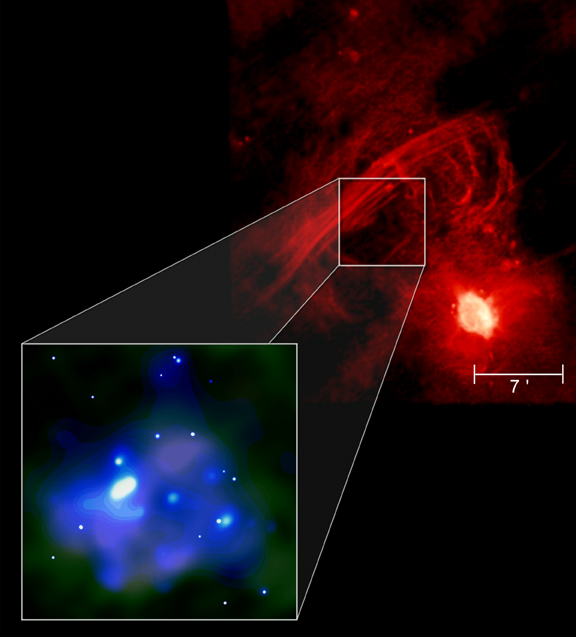Czerno wrote:Can someone please give an indication about the size covered by today, April 27 2008's picture both in terms of angular measurement and, while we're at it, distance and estimated real size ?
G'day,
When you click on "the above radio image" in the legend of todays APOD, and click further to image number 5, i.e.

you will see that todays APOD is slightly smaller than the size of the moon. I estimate it as 20-25 arc minutes. In a rather detailed article by Lazenby, Lazenby and Yusef-Zadeh the distance to the galactic center has been fixed at 8.5 kpc, so the size of the arc is about 100pc. (1pc ≅ 3.26 ly).
Czerno wrote:Generally I'd appreciate if the angular size of the area shown was alwas given with APOD ! I think I emailed Robert Nemiroff with a similar request, years ago, so let this be a gentle & humble reminder.
I do not know how an APOD is chosen and delivered to the webmaster. I guess a webmaster can not impose demands to people that voluntary provide us with images: "Now add a scale to the image!". The only sanction would be: not to publish the image, which is not in the interest of APOD visitors. Nonetheless i second your request for "adding scales to images".
I was puzzled by what "optical depth" is. I found an answer at:
http://en.wikipedia.org/wiki/Optical_depth
Optical depth is the key to understand the Lazenby et al. article.
What is nice to see is that the good old 21 cm H1 line has been used to determine the geometry of the arc and relate it to the Sgr A source.
Regards
[quote="Czerno"]Can someone please give an indication about the size covered by today, April 27 2008's picture both in terms of angular measurement and, while we're at it, distance and estimated real size ?[/quote]
G'day,
When you click on "the above radio image" in the legend of todays APOD, and click further to image number 5, i.e. [img]http://chandra.harvard.edu/photo/2002/gradioarc/GRadioArc_scale.jpg[/img]
you will see that todays APOD is slightly smaller than the size of the moon. I estimate it as 20-25 arc minutes. In a rather detailed article by Lazenby, Lazenby and Yusef-Zadeh the distance to the galactic center has been fixed at 8.5 kpc, so the size of the arc is about 100pc. (1pc ≅ 3.26 ly).
[quote="Czerno"]Generally I'd appreciate if the angular size of the area shown was alwas given with APOD ! I think I emailed Robert Nemiroff with a similar request, years ago, so let this be a gentle & humble reminder.[/quote]
I do not know how an APOD is chosen and delivered to the webmaster. I guess a webmaster can not impose demands to people that voluntary provide us with images: "Now add a scale to the image!". The only sanction would be: not to publish the image, which is not in the interest of APOD visitors. Nonetheless i second your request for "adding scales to images".
I was puzzled by what "optical depth" is. I found an answer at:
[url]http://en.wikipedia.org/wiki/Optical_depth[/url]
Optical depth is the key to understand the Lazenby et al. article.
What is nice to see is that the good old 21 cm H1 line has been used to determine the geometry of the arc and relate it to the Sgr A source.
Regards